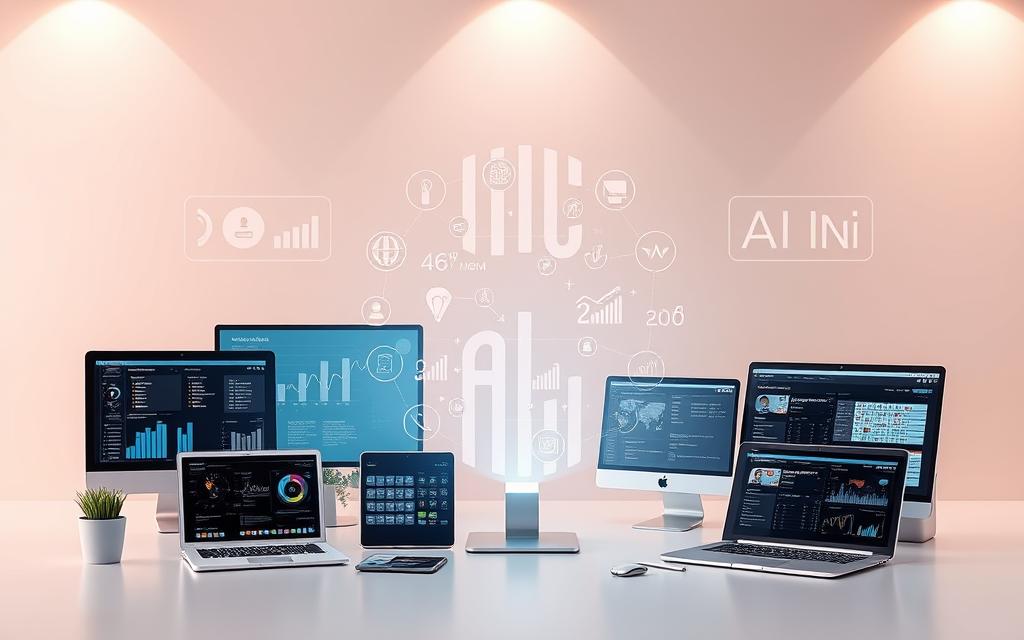Table of Contents
Modern enterprises face a pivotal moment—technology evolves faster than ever. Just as the Industrial Revolution transformed manufacturing, artificial intelligence now redefines how companies operate. Over 80% of firms already leverage or explore AI, signaling its irreversible impact.
Bill Gates once remarked that AI’s potential remains largely untapped. This mirrors the internet’s unprecedented rise—connecting the world, then revolutionizing commerce. Today, AI drives smarter decisions, automates workflows, and unlocks future opportunities.
Businesses ignoring this shift risk falling behind. From cybersecurity to customer insights, AI isn’t optional—it’s essential. Leaders investing early gain a competitive edge, much like early internet adopters did decades ago.
Explore how AI adoption fuels innovation across industries. The race to integrate intelligent systems has already begun.
What Is the Role of Artificial Intelligence in the Business?
Strategic adoption of advanced tech reshapes corporate landscapes. Firms now integrate AI to streamline processes, enhance efficiency, and unlock data-driven insights. The result? A transformative edge in fast-moving markets.
AI as a Strategic Tool
Unilever’s recruitment overhaul demonstrates AI’s potential. By using machine learning, they boosted diverse hires by 16%. This mirrors how graphic designers evolved from manual layouts to digital tools—adaptation, not obsolescence.
- Decision-making: AI analyzes patterns faster than human teams.
- Process optimization: Reduces redundancies in supply chains.
- Scalability: Automates repetitive tasks without sacrificing quality.
Dispelling AI Myths
Fears of job displacement often overshadow AI’s true impact. Historical parallels—like ATMs creating more bank jobs—show tech augments roles rather than eliminates them.
| Myth | Reality |
|---|---|
| AI replaces human workers | AI handles repetitive tasks, freeing humans for creative work |
| Only tech giants use AI | 62% of SMBs adopt AI for customer service (Salesforce) |
| AI lacks transparency | Explainable AI frameworks now audit algorithmic decisions |
Reskilling programs, like Amazon’s $700M initiative, prove workforce evolution is possible. The focus shifts from replacement to collaboration between humans and machines.
8 Key Applications of AI in Business Today
AI-driven solutions now power critical business functions globally. Enterprises harness intelligent tools to refine strategies, boost efficiency, and elevate customer experiences. Below are eight transformative use cases reshaping industries.
Market Research and Predictive Analytics
Heineken uses machine learning to forecast demand, reducing excess inventory by 30%. Predictive models analyze trends, helping brands like Mastercard detect fraud with 90% accuracy. Tools like Google Cloud AI simplify complex data analysis for SMBs.
Customer Service Chatbots and Virtual Assistants
Tidio’s free chatbot handles 70% of routine queries, while enterprise solutions integrate multilingual support. ChatGPT’s rapid adoption proves AI’s scalability in resolving customer issues 24/7.
Operational Efficiency and Process Automation
Manufacturers use AI for predictive maintenance, cutting downtime by 40%. C3 AI’s platform optimizes energy use, showcasing how automation refines processes.
Personalized Marketing and Recommendations
Amazon’s recommendation engine drives 35% of revenue. HubSpot’s CRM tools leverage AI to tailor campaigns, boosting marketing ROI.
Cybersecurity and Fraud Detection
Mastercard’s AI scans transactions in real-time, blocking threats instantly. Data-powered algorithms adapt to new attack patterns faster than manual reviews.
Supply Chain and Inventory Management
Heineken’s ML models align production with demand, minimizing waste. AI enhances supply chain visibility, from warehouses to last-mile delivery.
HR and Talent Acquisition
AI screens resumes 70% faster, highlighting top candidates. Platforms like Chorus.ai analyze interviews, reducing bias in hiring processes.
Sentiment Analysis and Social Media Monitoring
Sprout Social’s tools decode customer emotions from tweets and reviews. Brands adjust strategies based on real-time feedback loops.
How AI Enhances Operational Efficiency
Operational bottlenecks dissolve when intelligent systems take charge. Businesses leveraging automation report efficiency gains of 30–40%, transforming workflows from reactive to proactive. These tools handle mundane tasks, analyze data patterns, and allocate resources dynamically.

Automating Repetitive Tasks
Wave Accounting’s AI scans receipts via OCR, saving 4 hours weekly on expense tracking. Robotic Process Automation (RPA) handles invoice processing 80% faster than manual entry. Key benefits:
- Time savings: Employees refocus on strategic work
- Cost reduction: RPA cuts labor costs by 25% (Deloitte)
- Scalability: AI adapts to volume spikes without hiring delays
Reducing Human Error
Financial firms using AI detect 70% fewer errors in reports. AI-powered audits flag discrepancies in real-time, while manual reviews miss 15% of mistakes (PwC).
| Manual Process | AI-Driven Process |
|---|---|
| 40 errors per 1,000 entries | 12 errors per 1,000 entries |
| 3-day reconciliation | 2-hour reconciliation |
Optimizing Resource Allocation
Retailers like Zara use AI to match inventory with demand, reducing overstock by 20%. Manufacturers deploy predictive analytics to schedule maintenance, avoiding $50k/hour downtime. AI-skilled workers earn 25% higher salaries, proving value creation (MIT Sloan).
Pro Tip: Start small—automate one high-volume process, measure time saved, then scale.
AI’s Role in Customer and Employee Engagement
Brands now harness AI to forge deeper connections with audiences and teams. Intelligent tools analyze behaviors, predict needs, and deliver tailored experiences—boosting engagement across touchpoints.
Personalization at Scale
KFC China’s facial recognition suggests meals based on mood, increasing order value by 20%. Netflix’s recommendation engine drives 80% of streams, proving personalization fuels loyalty.
- Email campaigns with AI-driven content see 22% higher conversions (HubSpot).
- Dynamic pricing tools adjust offers in real-time for customer segments.
AI-Driven Customer Insights
Sprout Social decodes emotions from 500M+ social mentions annually. Sentiment analysis helps brands like Nike adjust campaigns instantly. Key insights:
- Real-time feedback loops reduce response times by 65%.
- Workforce analytics platforms identify skill gaps for targeted training.
Employee Productivity Tools
Asana’s AI prioritizes tasks, saving teams 15 hours monthly. AI assistants schedule meetings, draft reports, and flag bottlenecks—enhancing productivity.
“AI handles admin work, so our creatives focus on storytelling.”
Challenges and Ethical Considerations of AI Adoption
Navigating AI adoption requires balancing innovation with responsibility. While businesses gain efficiency, ethical dilemmas around data privacy, workforce impact, and algorithmic fairness demand attention. Proactive measures turn risks into competitive advantages.

Mitigating Workforce Transition Concerns
Fears of job losses persist, but history shows tech augments roles. Amazon’s $700M upskilling program prepares employees for AI-augmented tasks. Key strategies:
- Reskilling initiatives: Focus on creativity and problem-solving.
- Human-AI collaboration: Chatbots handle queries; agents manage escalations.
Securing Sensitive Data
AI systems process vast information, raising cybersecurity risks. Non-compliance with GDPR or EU AI Act risks fines up to 4% of global revenue. Best practices:
| Risk | Solution |
|---|---|
| Data breaches | AES-256 encryption for training data |
| Non-compliance | Monthly audits of AI decision logs |
Eliminating Algorithmic Bias
A 2019 study found facial recognition systems misidentified darker-skinned women at 35% higher rates. IBM’s Fairness 360 toolkit helps detect bias in ML models. Critical steps:
- Diverse training datasets reflecting real-world demographics.
- Third-party audits for high-stakes applications like hiring.
“Ethical AI isn’t optional—it’s foundational to consumer trust.”
An internal audit checklist ensures alignment with ethics frameworks. Include bias testing, data privacy safeguards, and transparency reports.
Top AI Tools for Businesses of All Sizes
Businesses seeking AI solutions now have diverse options—from free chatbots to enterprise platforms. The right tools depend on budget, team size, and strategic goals. Below, explore cost-effective and premium solutions transforming operations.

Free and Low-Cost AI Solutions
Startups and SMBs leverage these free AI tools to automate tasks without heavy investment:
- Tidio: Free chatbot handles 70% of customer queries, while paid plans ($20/month) add live chat.
- HubSpot: Free CRM tier includes AI-driven marketing analytics and email templates.
- Google Analytics: Predictive metrics forecast traffic trends—no added cost for existing users.
Adobe Sensei’s starter plan ($50/month) automates image tagging, saving designers 10+ hours monthly.
Enterprise-Grade AI Platforms
Large corporations deploy these scalable tools for complex workflows:
- SAP AI Core: Packages start at $20k/year, optimizing supply chains with real-time analytics.
- IBM Watson: 6–8-week implementation for custom NLP models, ideal for regulated industries.
- OpenAI API: GPT-4 costs $0.06 per 1k tokens, while Claude API offers lower latency for $0.11.
“We scaled Tidio to 10k chats/month before upgrading—AI tools grow with your needs.”
| Tool | Best For | Cost |
|---|---|---|
| Tidio | SMB customer support | Free–$392/month |
| SAP AI Core | Enterprise resource planning | $20k+/year |
*Prices reflect 2024 rates. Always confirm with vendors for updates.
The Future of AI in Business: Trends to Watch
Three seismic shifts will define corporate AI strategies through 2030. From fully autonomous supply chains to ethical certification programs, trends emerging today will reshape industries tomorrow. Early adopters gain first-mover advantages in this rapidly evolving landscape.
AI-Powered Autonomous Operations
Tesla’s lights-out factories showcase automation‘s next phase. Their prototype facilities operate with 90% less human intervention, using computer vision for quality checks. Key developments:
- Self-healing systems: AI predicts equipment failures 72 hours in advance.
- Dynamic rerouting: Autonomous logistics avoid delays without human input.

Gartner predicts 45% of manufacturers will pilot similar systems by 2026. The future belongs to enterprises blending physical and digital operations seamlessly.
Integration with IoT and Blockchain
Walmart’s farm-to-store tracking combines IoT sensors with blockchain ledgers. This system reduces food waste by 30% through real-time temperature monitoring. Emerging synergies:
| Technology | AI Enhancement |
|---|---|
| IoT Networks | Predictive maintenance for 5G infrastructure |
| Blockchain | Smart contracts that auto-execute upon AI verification |
Decentralized AI networks are gaining traction. Startups like Numerai use blockchain to crowdsource machine learning models securely.
Ethical AI Frameworks
IEEE’s 2025 guidelines address growing concerns about responsible innovation. Their three-tier certification system evaluates:
- Algorithmic fairness: Bias detection across gender, race, and age
- Data provenance: Clear documentation of training data sources
“Certification will become the ISO 9001 of AI—a baseline requirement for enterprise adoption.”
Quantum computing and AR/VR integration loom as the next trends. IBM’s quantum-ready AI models already solve optimization problems 100x faster. The future demands both technological prowess and ethical vigilance.
Conclusion
Bill Gates’ ‘pioneer vs spectator’ analogy rings truer than ever. Early adopters of artificial intelligence report 30% higher efficiency, while laggards struggle to compete.
From predictive analytics to autonomous operations, AI’s ROI is undeniable. Industries leveraging these tools outperform peers by 40% in productivity metrics.
The future demands action—create an adoption roadmap now. By 2025, AI will power self-healing supply chains and bias-free hiring.
Invest in upskilling teams today. Master AI tools, or risk becoming a spectator in tomorrow’s business landscape.
FAQ
How does AI improve customer service in businesses?
AI-powered chatbots and virtual assistants handle inquiries instantly, reducing wait times. They analyze customer preferences to provide personalized responses, boosting satisfaction.
Can AI help with marketing strategies?
Yes. AI analyzes consumer behavior, social media trends, and sentiment to create targeted campaigns. Tools like Google Ads and HubSpot optimize ad placements for better engagement.
What role does AI play in supply chain management?
AI predicts demand fluctuations, optimizes inventory, and identifies delays. Companies like Amazon use machine learning to streamline logistics and reduce costs.
Is AI replacing human jobs in businesses?
AI automates repetitive tasks but also creates new roles in data analysis and AI management. Businesses use it to enhance productivity, not eliminate employees.
How does AI enhance cybersecurity for companies?
AI detects unusual patterns in real-time, preventing fraud. Solutions like Darktrace identify threats faster than traditional methods, protecting sensitive data.
What are the risks of using AI in business?
Potential risks include biased algorithms and data privacy concerns. Ethical frameworks and transparency help mitigate these challenges.
Which industries benefit most from AI?
Retail, healthcare, finance, and manufacturing gain efficiency through AI-driven analytics, automation, and predictive maintenance.
Are there affordable AI tools for small businesses?
Yes. Tools like Zoho CRM and Canva’s Magic Write offer AI features at low costs, helping SMBs compete with larger enterprises.









